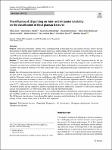Thông tin tài liệu
Thông tin siêu dữ liệu biểu ghi
| Trường DC | Giá trị | Ngôn ngữ |
|---|---|---|
| dc.contributor.author | Tobias, Dust | - |
| dc.contributor.author | Maximilian J., Hartel | - |
| dc.contributor.author | Julian-Elias, Henneberg | - |
| dc.date.accessioned | 2023-03-24T06:52:02Z | - |
| dc.date.available | 2023-03-24T06:52:02Z | - |
| dc.date.issued | 2023 | - |
| dc.identifier.uri | https://link.springer.com/article/10.1007/s00068-022-02055-1 | - |
| dc.identifier.uri | https://dlib.phenikaa-uni.edu.vn/handle/PNK/7142 | - |
| dc.description | CC BY | vi |
| dc.description.abstract | Tibial plateau fractures continue to be a challenging task in clinical practice and current outcomes seem to provide the potential for further improvement. Especially presurgical understanding of the orientation of fracture lines and fracture severity is an essential key to sufficient surgical treatment. The object of this study was to evaluate the reliability of modern axial CT-based classification systems for tibial plateau fractures. In addition, the diagnostic-added value of 3D printing on the classification systems was investigated. | vi |
| dc.language.iso | en | vi |
| dc.publisher | Springer | vi |
| dc.subject | clinical practice | vi |
| dc.subject | orientation | vi |
| dc.title | The influence of 3D printing on inter- and intrarater reliability on the classification of tibial plateau fractures | vi |
| dc.type | Book | vi |
| Bộ sưu tập | ||
| OER- Y học- Điều dưỡng | ||
Danh sách tệp tin đính kèm:

